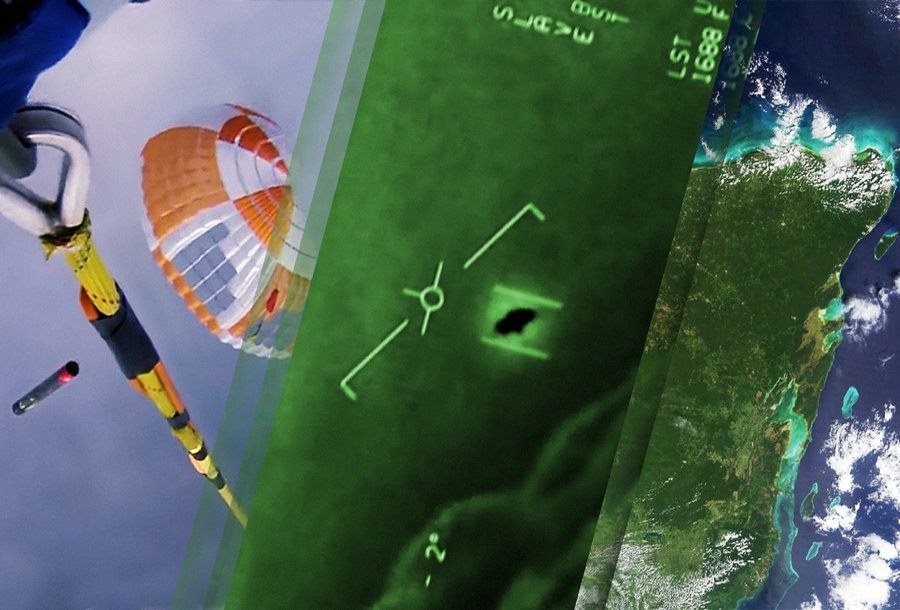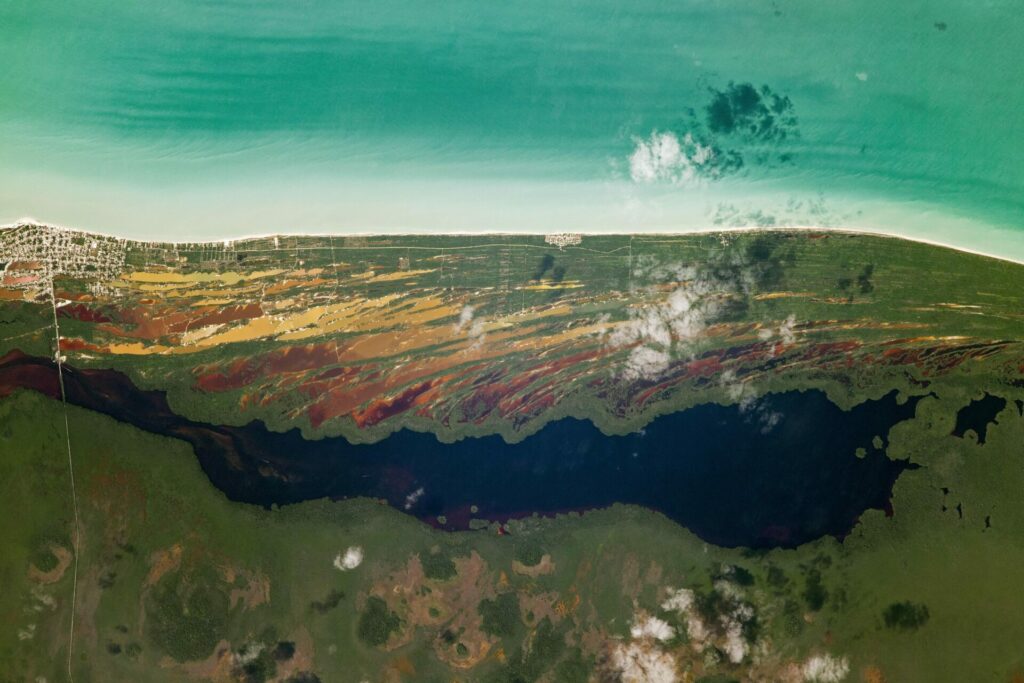Selection of space news for breakfast: Ukraine is ready to join the European Space Agency. Astronauts have photographed the place of death of dinosaurs from the ISS, and the crew of the Polaris Dawn mission is ready to start training.

- Lack of “Antonovs” forces Maxar to postpone the launch of new observation satellites
- Liquid water on Mars stayed longer than thought
- Astronauts on Mars will be protected from radiation by a regolith shield
- Video of the day: Journey to space and back
- Ukraine may join the European Space Agency
- Crew of Polaris Dawn ready to start training
- Astra Space announces more powerful rocket
- Orion lunar capsule deployed solar wings from Airbus
- Place of the death of dinosaurs from space
- US intelligence to declassify the whole truth about UFOs
- Stars Doomed to Die Defied Planetary Science
- “Fireball” of a dead star confirmed a 30-year-old prediction
Lack of “Antonovs” forces Maxar to postpone the launch of new observation satellites
Maxar Technologies will be able to launch the new WorldView Legion Earth observation satellites no earlier than September. The reason for this is the lack of Antonov Company aircraft for their transportation. Daniel Jablonski, President of Maxar Technologies, announces that the launch of the new WorldView Legion satellites has been postponed to September. According to Yablonsky, the reason for this was the shortage of Ukrainian Antonov aircraft, which arose as a result of the Ukrainian-Russian war. The world’s largest AN-225 Mriya aircraft was destroyed by Russian shelling, and the rest of the Ukrainian trucks had to be hastily evacuated. Now spacecraft weighing several tons will have to be transported by land or by sea.
Liquid water on Mars stayed longer than thought
Scientists working with the data of the Zhuzhong rover claim that the darker and lighter colored stones at the site of its work were formed under salt water. At the same time, this happened later than those 3 billion years ago, when, according to current concepts, this liquid began to disappear from the surface of the Red Planet. The sensation is that these rocks date back to the Middle Amazon epoch, which lasted from 2.1 billion to 200 million years ago. It is in the area where Zhuzhong works that the age of rocks is estimated at 700 million years. This means that liquid water has been present on the red planet for much longer than previously thought.
Astronauts on Mars will be protected from radiation by a regolith shield
In 10-15 years, humanity will be able to land on Mars. However, in addition to the long flight and the difficulty of landing on astronauts, there is a great danger on the Red Planet – high radiation exposure due to the thin atmosphere, which does not protect against cosmic radiation. Planetary scientists have found a way to protect themselves from harmful radiation. They suggested that deepening under the surface of the Red Planet could protect astronauts from harmful radiation. Moreover, the resulting material after digging can be used to create a habitat.
Market News
Video of the day: Journey to space and back
Rocket Lab has published a very spectacular video. It demonstrates the main stages of catching the first stage of the Electron rocket returned from space. The recording is made up of footage taken by cameras installed both on board the stage and the helicopter that caught it. The video was made on May 3, 2022. On that day, Rocket Lab carried out the 26th launch of the Electron rocket. The purpose of the mission was to launch 34 satellites from various commercial customers into orbit.
Ukraine may join the European Space Agency
Ukraine could join the European Space Agency (ESA). The country has numerous enterprises operating in this industry. Therefore, our country may well replace Russia in many projects in Earth orbit and far beyond its borders. Ukraine has a lot to offer Europe in the space industry. The country has an established ground infrastructure and has long been an important manufacturer of rockets, launch vehicles and other types of space equipment.
Crew of Polaris Dawn ready to start training
The crew of the Polaris Dawn mission will begin training this month. The main goals of Polaris Dawn will be to conduct scientific research and test the capabilities of Crew Dragon. In a recent interview, Isaakman said that the crew would begin training this month and confirmed that the spacecraft would be launched into orbit with an apogee of 1400 km. Таким образом, Polaris Thus, Polaris Dawn will surpass the record set back in 1966 by the Gemini 11 mission, which reached an altitude of 1,372 km (of course, the Apollo expeditions moved away from Earth at a much greater distance, but they did it during flights to the Moon, and not in near Earth orbit).
Astra Space announces more powerful rocket
On May 12, Astra Space announced its intention to build a new launch vehicle. It will have a higher payload capacity and will be able to make more frequent flights. The new rocket received the designation Rocket 4.0. Its length will be 19.4 meters, height — 1.8 meters. It will be able to carry up to 300 kg of cargo into low Earth orbit (LEO) and up to 200 kg into sun-synchronous orbits (SSO). For comparison, the current Rocket 3.3 carrier has the ability to take up to 50 kg of cargo to the SSO. Astra intends to achieve an increase in load capacity by redesigning the first stage. Rocket 4.0 will receive two new engines, whose total thrust will be twice the thrust of the five Delphin engines installed on the first stage of Rocket 3.3.
Orion lunar capsule deployed solar wings from Airbus
The European Space Agency (ESA) has moved on to the next stage of testing the Orion spacecraft. This spacecraft will be launched to the Moon on a NASA Space Launch System (SLS) rocket as part of the Artemis mission in late 2022. Engineers have tested the deployment of massive “wings” – Orion solar panels that will provide the spacecraft with electricity. In a video posted by ESA, the mission team deploys solar panels, the power of which is sufficient to power two residential buildings.
Interesting

Place of the death of dinosaurs from space
The presented image was taken by one of the ISS crew members. It https://universemagazine.com/en/place-of-the-death-of-dinosaurs-from-space-photo/. 65 million years ago, it took the impact of a cosmic body with a diameter of about 10 km. According to the most popular version to date, it was this event that led to the mass extinction of terrestrial species that killed the dinosaurs.
US intelligence to declassify the whole truth about UFOs
The House of Representatives will hold a public hearing on UFOs and shed light on the greatest mystery about these mysterious objects. The UFO phenomenon has captured the public imagination for a century, but interest in “flying saucers” was intensified after the famous Roswell incident. The Subcommittee on Counterterrorism and Counterintelligence of the U.S. House of Representatives will try to shed light on UFOs at a public hearing on Tuesday, May 17. Representatives of the Pentagon and US intelligence will also testify.
Stars Doomed to Die Defied Planetary Science
Of the 5,000 exoplanets discovered to date, 90% orbit stars the same size or smaller than our Sun. But giant stars don’t seem to have planets of their own. This fact has serious implications for understanding the formation of the Solar system. But is the lack of planets around large stars a true reflection of the nature of the Universe? The recent discovery of two gas giants orbiting a subgiant called µ2 Scorpio suggests that there are exceptions to the rule. Modern theoretical models of planet formation cannot explain the formation of planets in such stars yet. The planet formation core accretion model, in which dust slowly collects into the planetary core over millions of years, in theory cannot exist around massive stars where protoplanetary disks disperse faster.
“Fireball” of a dead star confirmed a 30-year-old prediction
A short-lived but enormously powerful eruption of a dead star was captured by one of the most powerful X-ray instruments in space. The joint German-Russian eROSITA telescope on board the Spektr-RG Space Observatory at the L2 Lagrange point first caught the so-called “fireball” phase of a classical nova. These X-ray data finally confirmed the 1990 prediction about the physics of new stars. The nova in question, known as YZ Reticuli, was discovered on July 15, 2020 at a distance of about 8250 light-years near the southern constellation Reticulum. The analysis showed that this short-term increase in brightness was the result of what we call a classic nova – the eruption of a white dwarf.
Follow us on Twitter to get the most interesting space news in time
https://twitter.com/ust_magazine
